What You Should Know about Replacing Your Roof and Asphalt Shingles
It’s time to replace your roof. Where do you start? This is the exact predicament I found myself in after the tree fell on our house a few weeks ago. Choosing shingles and roofing material in less than 48 hours had me in a panic. Don’t they know that I need time to thoroughly research shingles, colors, warranties, etc.? Lucky for us, our insurance company turned our claim over to the restoration company who has a roofer they use. So, I was able to fast forward past the process of hiring a roofer.
Hiring a roofer:
If you need to hire a roofer, do your research. Ask for referrals. Check on Angie’s List. Check with the Better Business Bureau. Do your homework on this one! Investing in a new roof is no small expense and quality installation is key to preventing problems down the road. Also, MAKE SURE THE ROOFER IS LICENSED AND INSURED! Don’t just take “yes” as an answer to this question. Ask to see the policy or get the insurance company name, number and their policy number so you can call and verify. I can’t overstress how important this is because I know someone whose roofer fell of their roof. Luckily he lived and luckily she wasn’t sued. But, this always makes me think twice.
When to replace your roof:
If you start to see torn, damaged, or missing shingles. Or if you discover water leaks, or holes in your roof, it is time to get a new roof ASAP. Delaying the process can only lead to costly repairs to your home (both inside and out.) And repairing an old roof is usually only putting a band-aid on the problem.
Types of roofing material:
There are numerous types of roofing material. Metal (read more about our little copper roof here), slate, composite, clay tile, wood shakes, and asphalt shingles are possible materials. Your decision will likely come down to budget, location, and personal preference. I will focus on asphalt shingles since they are the most popular budget conscious —if spending several thousand dollars can be considered budget conscious—and they are what we chose to use.
Architectural vs. Traditional 3 tab shingles:
Architectural shingles (also referred to as laminated or dimensional shingles) are the latest addition to the shingle line up. Most homeowners who are looking for an upgrade in style and function chose architectural shingles. They cost about 20% more than the traditional three tab shingles. The steeper cost isn’t just paying for good looks. The architectural shingles are thicker because they are made up of several layers of laminated shingles. Therefore they are heavier and much more resistant to wind and storm damage. They are less likely to warp and wear like a three tab shingle. Architectural shingles also typically have a longer warranty. Some architectural shingles come with a 40-50 year warranty (termed lifetime) compared to a 20-30 year warranty for three tab shingles. Plus, architectural shingles are rated up to 110 mile per hour winds compared to 70 mile an hour for three tab shingles.
How to pick colors:
Once you’ve narrowed down your decision to type of shingles and brand. Ask your roofer if they have samples or where you can get sample boards. The sample board will have a few rows of the actual shingles glued to a board. This is a good place to start.
Narrow your choice down to 3-4 colors you like. Then ask to borrow a sample board of each color. (Local building supply companies usually have several of these on hand. Or ask your roofer to get you some.)
Bring those sample boards home and set them up against your house. Look at them from a distance. Ask your friends, neighbors, and family members to weigh in. Sometimes it takes someone else’s top choice to help you realize that you don’t like that one.
Once you think you have it narrowed down to a few colors, ask your roofer for a list of local jobs using those colors. Then do a drive by and accept that you’ll get strange looks as you snap pictures of random strangers’ homes. Seeing the shingles installed on a roof at full scale is truly the best way to color shop.
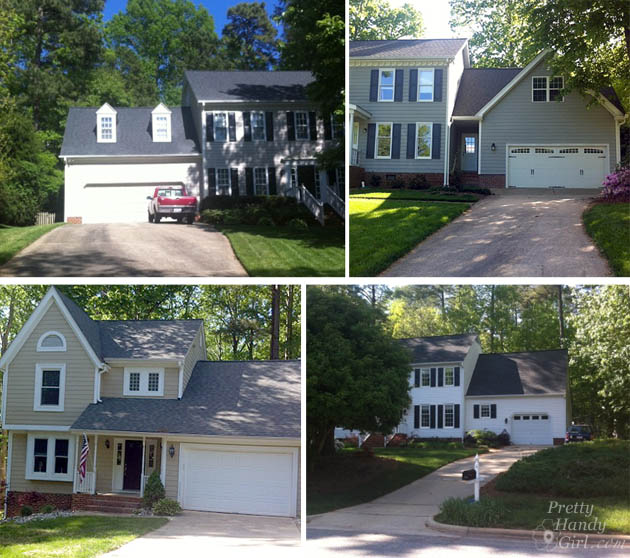 (CertainTeed Landmark colors clockwise from top left: Moire Black, Weathered Wood, Georgetown Gray, Charcoal)
(CertainTeed Landmark colors clockwise from top left: Moire Black, Weathered Wood, Georgetown Gray, Charcoal)
Some shingle manufacturers have a feature where you can pay to upload your house picture and they will build a mask so you can visualize the different colors on your home. Certainteed has this feature for a price, but it also takes several days for them to process your request (remember I only had 48 hours!)
Estimating Your Roof size:
Shingles are sold in squares. Each square (or bundle) is 100 sq. feet. A traditional 2,300 square foot home usually has approximately a 30 square roof, plus an additional 10% for waste. If you have a garage, porch or other structures, you’ll need to account for their coverage as well. And if you have a cape cod or dutch colonial (like we do), you’ll need to allow for more squares to cover the front where the roof extends over the 2nd floor. (For comparison, our home is 2700 sq. feet with a 2 car garage, screen porch, and laundry room bump out. Our roof was about 50 squares.)
To layer or to strip:
Building codes usually allow you to add another layer of shingles onto a previous layer. If you already have two layers you will need to strip your roof down to the plywood sub-layer. But, before you consider layering, be aware that adding a second roof layer will add weight and stress to your rafters. Another reason NOT to layer is that wood rot and damage may be hidden. I highly recommend starting fresh with your roofing layer. If we hadn’t started from scratch, the roofer would never have noticed the underlying wood rot.
Proper prep-work:
After the old shingles and tar paper are removed down to the wood, your roofer should assess and repair any damaged wood. After repairs are complete, new tar paper (or felt paper) is laid on top of the plywood. Then the roofer will mark horizontal lines on the roof to use as a guide for keeping the shingle rows even and parallel.
Flashing:
My goodness, we’ve gone from stripping to flashing. I thought this was a G-rated blog! Sorry, I couldn’t resist. Flashing is required anywhere where two different surfaces on the roof meet (i.e. chimney, dormer windows, different roof lines, etc.) I can’t stress how important it is for your roofing professional (or you) to use proper flashing on your home. The best flashing around dormer windows, chimneys, and other changes in roof surface is step flashing.
Strip flashing can be used on vertical locations, but the angled rooflines of our house was not the place to use them.
Strip flashing on the dormer window was not enough to prevent water from working its way under the shingles. Over time the water was running under the flashing and rotting out the plywood underneath. After it had rotted through the plywood, it got busy rotting the rafters that hold up the roof! Do you see why flashing is important?
Instead, the dormer windows should have been step flashed. Here is a little example of the layering process of step flashing.
It starts from the bottom with one piece of step flashing. Then one row of shingles is set on top of the flashing. Next another piece of step flashing and the next course of shingles. And so on until you reach the top of the window, chimney, or wall you are roofing against.
Educate yourself on proper installation:
Okay, I get it, you’re not a roofing pro. But, that doesn’t mean you can’t be aware of proper shingle installation techniques. You wouldn’t buy a car without learning some of the important technical specs would you? Well, you should take time to learn a little bit about roofing specs too.
Most manufacturers make this education easy for you (and your installer.) They’ve put the instructions on the back of the packaging. If you’ve read the instructions, don’t be afraid to ask your roofer if you see something that doesn’t look like the instructions.
Warranties:
After your roof has been installed, make sure you receive the appropriate receipts and warranty paperwork.
Enjoy your new roof and the piece of mind that comes with knowing you are leak-free.
Soooo, are you curious which color we chose? The winner with a unanimous vote (by our four family members) was…
Moire Black! Which ironically is actually a tad lighter than the Charcoal color.
Here’s a little before and after picture:
The previous green shingles really dictated potential house paint colors. I really like that the new roof color will coordinate with any house color we may choose in the future. Plus, if we ever sell, it is a nice neutral color.
What do you think? Do you like the new roof? I’ll tell you what I like, no holes in the roof!
 Disclosure: No disclosure necessary. This is not a sponsored post, nor was I compensated. We chose CertainTeed under the recommendations of the roofer and several local builders…and my Father-in-law ;-), who is my go to research assistant.
Disclosure: No disclosure necessary. This is not a sponsored post, nor was I compensated. We chose CertainTeed under the recommendations of the roofer and several local builders…and my Father-in-law ;-), who is my go to research assistant.

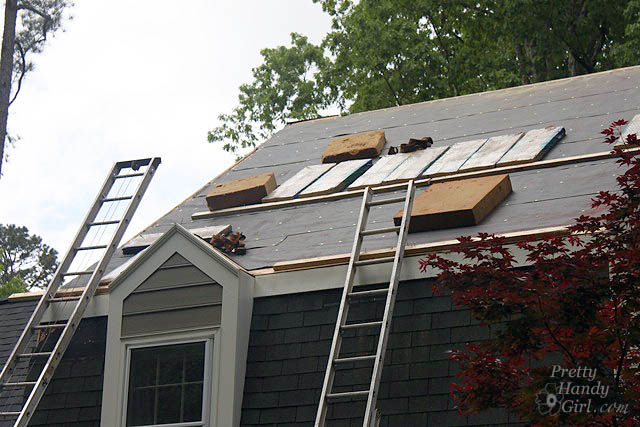

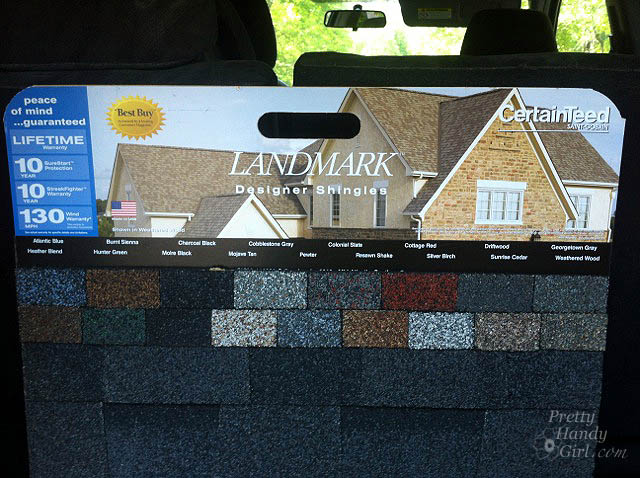
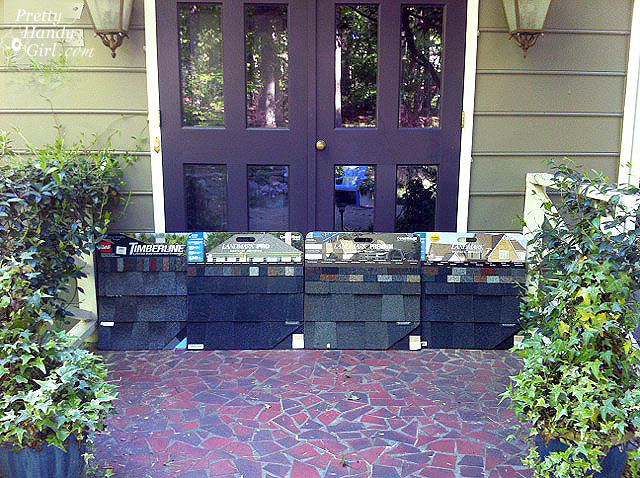
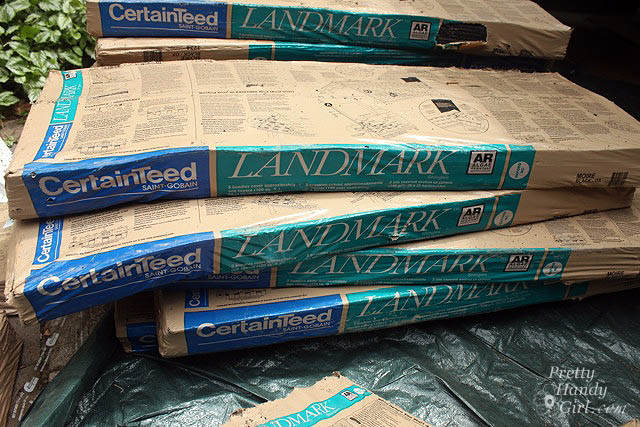
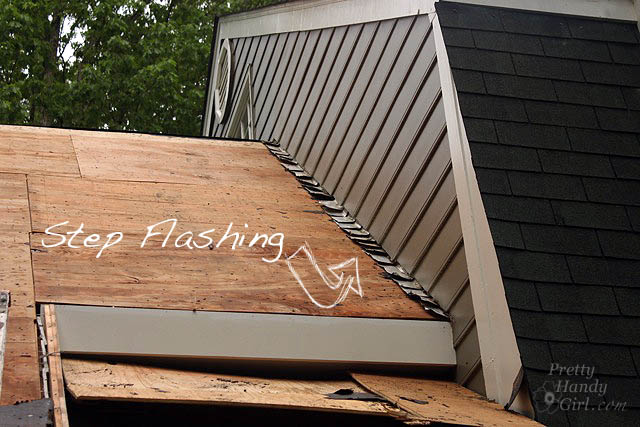
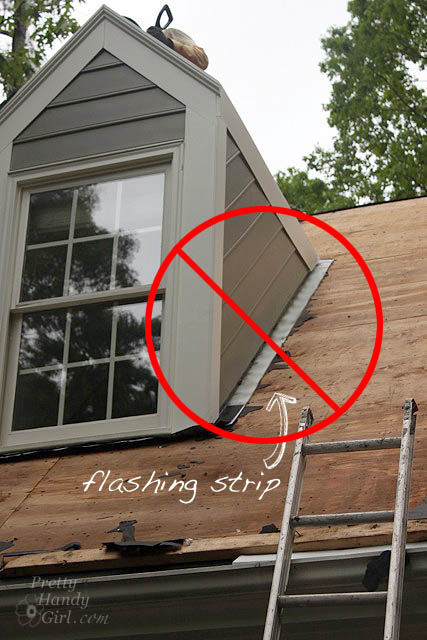
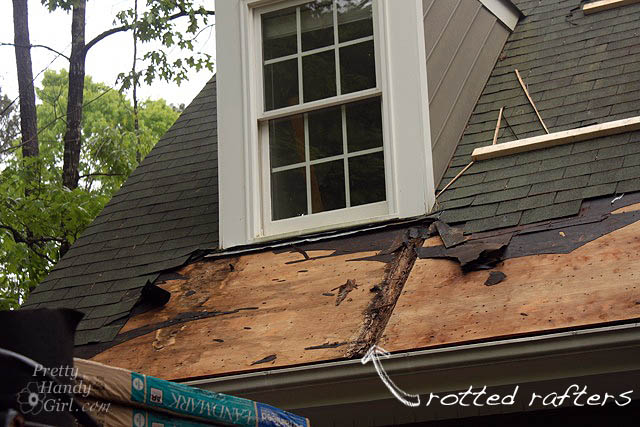
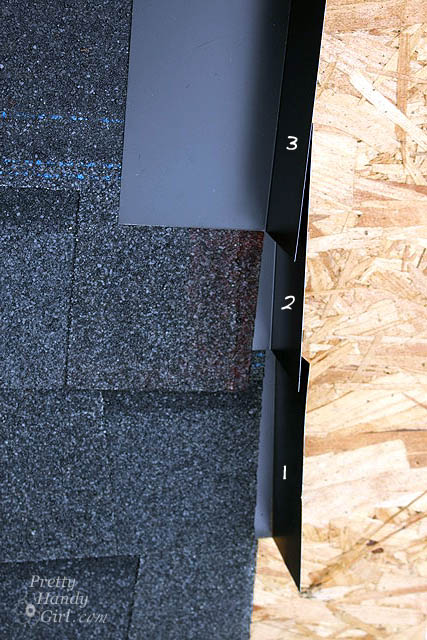
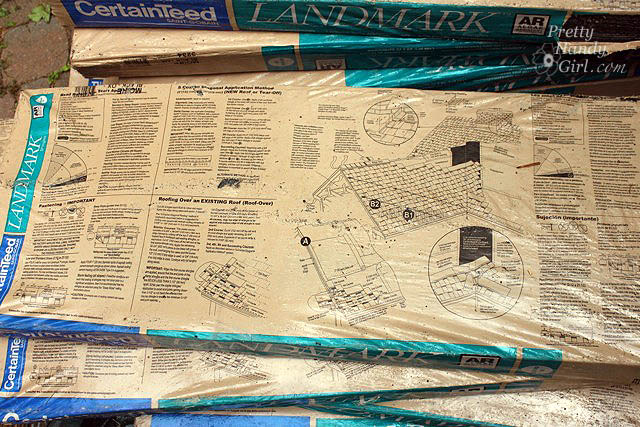
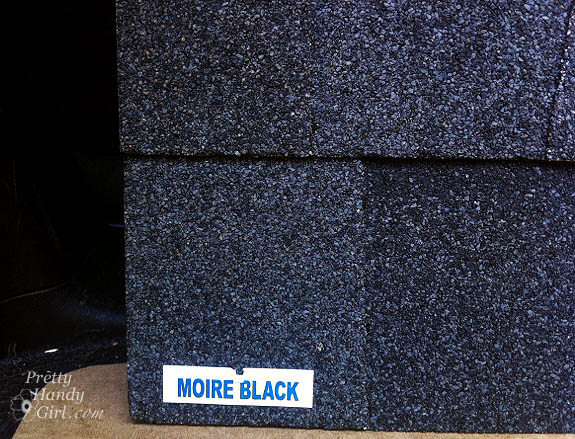
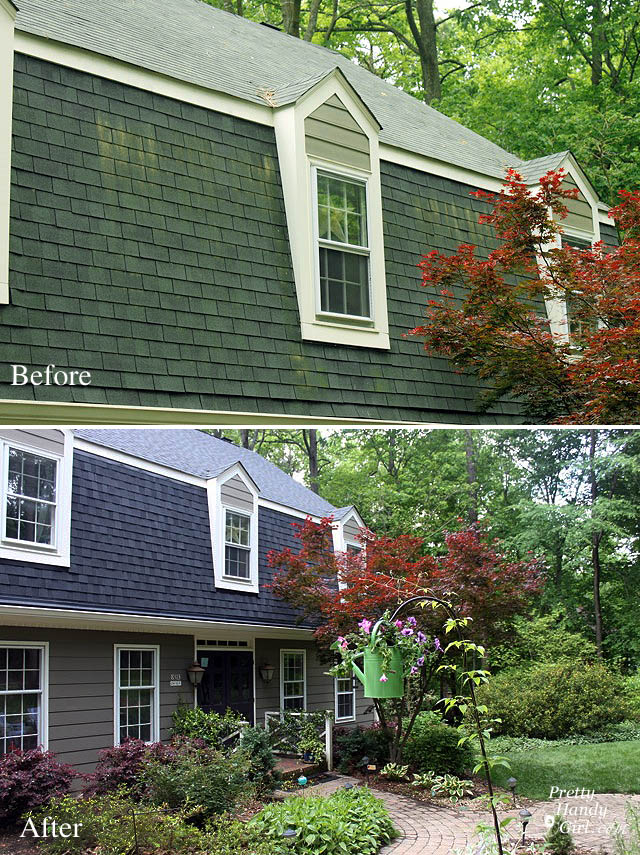


Hi Brittany,
I stumbled upon your website while looking for advice about roof replacement; and lo and behold, we are in the same area! Your advice is really helpful for me, especially the mini details regarding the flashing and check for insurance). Would you mind telling me the roofers that you can recommend please? Thank you very much in advance!
Sasha
I have a 60’s modern home with mostly a flat roof. I am thinking of painting wood arounf home a cedar color with a copper collored shiny flashing. it will be about 7 inches of flashing. The cedar color matches the fence.I can’t find any pictures like that. Wondering if it would be better to use a wicker flashing? New roof is tan and house is painted brick that’s beige. Your opinion please?
Sandy, I’m having a hard time picturing your roof. Do you want to send me a picture via email? [email protected]
Hi, Brittany,
I notice that this blog is a few years old, but I’m thrilled to have found it via google. I just discovered that I have hail damage and will require a new roof. I have zero knowledge of how to go about hiring a contractor, let alone the cosmetics of choosing the color. You have a beautiful home, and the moire black was, in my opinion, the perfect choice. Thanks for encapsulating “Roofing Basics” in this blog. Great idea about looking for homes already covered in the shingle selection you think you want. You have made a daunting task a little less overwhelming. If only I lived where your roofer works…..LOL
Hey Brittany!
I live in Knightdale and would love to know which roofer you used. Could you email the name of the company? Thanks!!
Chris
Chris, I’m not sure the name of his Roofing company, but his name is Gerald Rivera and his cell is: 919-809-2876. You can tell him Brittany, the lady who uses power tools and had the tree fall on her house referred you ;-). He doesn’t know I’m a blogger.
Brittany,
I was reading over the roofing section of your site and I must say you’ve covered alot of the important areas, proper flashing technique , Installation, warranty etc. Most impressive!!! I would like to add one more thing, when hiring ANY CONTRACTOR, always get the Contractor License # that they hold. The BBB is great , we have an A+ rating but in reality any business entity who has existed on paper for more than 1 year and $450 can have that rating. Angies list is a good one as well and they rave about us there but… anyone can manipulate that by having “friends” chime in. By getting the Contractors License # and checking with your state ( here in VA its the State Coporation Commission ) if any complaints have been filed it is on permanent record and can not be manipulated at all.
Great tips Jason. Thanks for chiming in ;-).
Can you please tell me the exterior color of your house?
It is a warm gray color that was a custom mix by the previous owners. The tag on the 5 gallon can says:
B1 Black: 10, 27, 1, 0
R2 Maroon: 0, 41, 0, 1
Y3 Deep Gold: 6, 58, 0, 0
If you took that to a Sherwin Williams store I bet they could match it 😉
gotta say hate hearing about the tree but you absolutely made lemonade and got a sweet boost in curb appeal in the process. Great info and a thorough post. all the best Brittany.
Looks great Brittany! Perfect choice & I bet you’re relieved this is behind you….or rather on top of you now!
I’m considering a new roof soon so I really appreciate all this information.
Your after photo looks great, but I’m confused – is that the same color roofing material on the front portion of your house as that on the roof?? they look like totally different colors and the roof doesn’t look black at all.
LindaSonia, it is just the different angles of the roof. The tops facing the sky look lighter and the front facing me are in shadow and darker. The roof is a dark gray color. Not really black at all (which is why I think it’s funny that the Charcoal color is actually more black and the Moire Black is actually more of a gray color.)
Our roof is about 12 years old, but does have some damage due to hail and wind storms. We are expecting to replace it in the near future, so this is a perfectly timed post for us! Thanks!
I love your roof! Every time the subject of our roof comes up, I discuss a lighter color shingle so as not to draw the heat in the summer. What are your thoughts about that?
I definitely considered this and after living with a green roof for seven years, the good looks of the dark gray won out. I think the lighter colors do look good on some houses, I just couldn’t do it on ours since half the front of our house is the roof!
Great job! My husband and I have owned a roofing company since 1997. I also cannot stress enough how important it is to require proof of insurance. So many customers think that if the business card says they are fully insured that it must be true…not! Also, one more step I would add for those of us living in cold climates with snow and ice, is the addition of ice and water shield.
Was happy to see you went with CertainTeed, that is also our first choice of a quality shingle!
Deborah, thanks for the compliment. Glad you didn’t find any errors. AND great addition about the ice/water shield. I will add that to the post right now!
Hi, Brittany,
First, I love your blog. It’s so great to see a woman not afraid to take on a power tool. I am also in the Raleigh area, and am in the market for a good roofer (once I convince my husband he is NOT going to do this himself!). Do you mind giving me the name of yours? Thanks so much!
Michelle, thank you for your comment. I will email you privately with the roofer’s name. He did an excellent job!